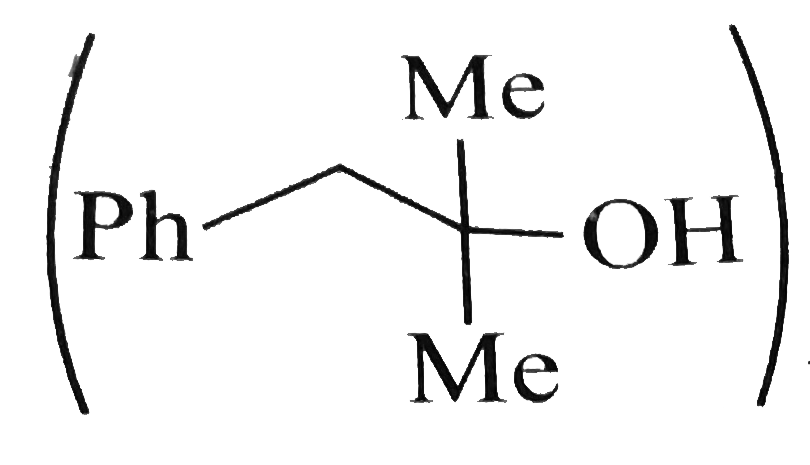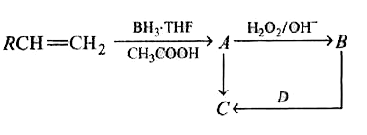Two different G.R.(A) and (B) give the product (X)  on reaction with (C) and (D) respectively. Give the structures of (A),(B),(C) and (D).
on reaction with (C) and (D) respectively. Give the structures of (A),(B),(C) and (D).
Product (X)  (2−Methyl−2−phenyl−∝an−2−ol) is a 3∘ alcohol which can be obtained by the reaction of ketone with G.R.
(2−Methyl−2−phenyl−∝an−2−ol) is a 3∘ alcohol which can be obtained by the reaction of ketone with G.R.
G.R can be either MeMgBr(A) or  (B).
(B).
The ketone can be either 
The reactions are as follows
 .
.
Topper's Solved these Questions
- GRIGNARD REAGENTS AND ORGANOMETALLIC REAGENTSBOOK - CENGAGE CHEMISTRY ENGLISHCHAPTER - GRIGNARD REAGENTS AND ORGANOMETALLIC REAGENTSEXERCISE - Exercises (Subjective )
17 Videos
- GRIGNARD REAGENTS AND ORGANOMETALLIC REAGENTSBOOK - CENGAGE CHEMISTRY ENGLISHCHAPTER - GRIGNARD REAGENTS AND ORGANOMETALLIC REAGENTSEXERCISE - Exercises (Linked Comprehension)
33 Videos
- GRIGNARD REAGENTS AND ORGANOMETALLIC REAGENTSBOOK - CENGAGE CHEMISTRY ENGLISHCHAPTER - GRIGNARD REAGENTS AND ORGANOMETALLIC REAGENTSEXERCISE - Exercises Archives (Linked Comprehension)
1 Videos
- GENERAL PRINCIPLES AND PROCESS OF ISOLATION OF ELEMENTSBOOK - CENGAGE CHEMISTRY ENGLISHCHAPTER - GENERAL PRINCIPLES AND PROCESS OF ISOLATION OF ELEMENTSEXERCISE - Archives (Subjective)
14 Videos
- NCERT BASED EXERCISEBOOK - CENGAGE CHEMISTRY ENGLISHCHAPTER - NCERT BASED EXERCISEEXERCISE - Nuclear Chemistry (NCERT Exercise)
29 Videos
Similar Questions
(A), (B) and (C ) are three non-cylic funtional isomers of a carbonyl compound with molecular formula C4H8O. Isomers (A) and (C ) give positive Tollen's test whereas isomer (B) does not give Tollens' test but gives positive iodoform test. Isomers (A) and (B) on reduction with Zn(Mg) | conc. HCl give the same product (D).
(a) Write the structures of (A), (B) ,(C) and (D).
(b) Out of (A), (B) and (C ) isomers, which one is least reactive towards addition of HCN ?
View Solution
Give the products (B) and (C) in the above reaction.
View Solution
Knowledge Check

In this sequence of reaction A, B, C and D are respectively :A(RCH2CH2)3,B,RCH2CH2OH,RCH2CH3,HIB(RCH2CH2)3B,RC∣OHHCH3,RCH2CH3,HIC(RCH2CH3)3B,RCH∣OH−CH2CH3,RCH2CH3,HIDnone of the above
An organic compound (A) (C6H10O) on reaction with CH3MgBr followed by acid treatment gives compound (B). The compound (B) on ozonolysis gives compound (C ), which in the presence of a base gives 1-acetyl cyclopentene (D). The compound (B) on reaction with HBr gives compound (E ). Write the structures of (A), (B), (C ), (D), and (E ). Show how (D) is formed from (C ).
View SolutionGive the products of the reactions given below.
b.
c.
d.
e.
View SolutionWrite the structures of A, B, C and D in the following reactions :

View SolutionDehydrobromination of compounds (A) and (B) yield the same alkene (C). Alkene (C) can regenerate (A) and (B) by the addition of HBr in the presence and absence of peroxide respectively. Hydrolysis of (A) and (B) give isomeric products (D) and (E) respectively. 1, 1-Diphenylethane is obtained on reaction of (C) with benzene in presence of H+. Give structures of (A) to (E) with reasons.
View SolutionDehydrobromination of compounds (A) and (B) yield the same alkene (C). Alkene (C) can regenerate (A) and (B) by the addition of HBr in the presence and absence of peroxide respectively. Hydrolysis of (A) and (B) give isomeric products (D) and (E) respectively. 1, 1-Diphenylethane is obtained on reaction of (C) with benzene in presence of H+. Give structures of (A) to (E) with reasons.
View SolutionDehydrobromination of compounds (A) and (B) yield the same alkene (C). Alkene (C) can regenerate (A) and (B) by the addition of HBr in the presence and absence of peroxide respectively. Hydrolysis of (A) and (B) give isomeric products (D) and (E) respectively. 1, 1-Diphenylethane is obtained on reaction of (C) with benzene in presence of H+. Give structures of (A) to (E) with reasons.
View SolutionWhen two reactants A and B are mixed to give products, C and D, the reaction quotient (Q) at the initial stages of the reaction
View Solution
